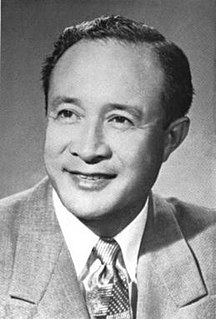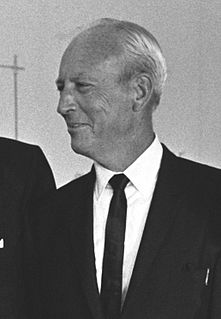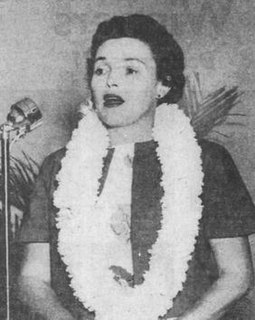
The Alaskan Independence Party (AKIP) is a political party and independence movement in the U.S. state of Alaska that advocates an in-state referendum which includes the option of Alaska becoming an independent country. The party also advocates positions similar to those of the Constitution Party, Republican Party and Libertarian Party, supporting gun rights, privatization, home schooling, and limited government.

Neil Abercrombie is an American politician who served as the seventh governor of Hawaii from 2010 to 2014. He is a member of the Democratic Party.

The Territory of Hawaii or Hawaii Territory was an organized incorporated territory of the United States that existed from August 12, 1898, until August 21, 1959, when most of its territory, excluding Palmyra Island and the Stewart Islands, was admitted to the Union as the fiftieth U.S. state, the State of Hawaii. The Hawaii Admission Act specified that the State of Hawaii would not include the distant Palmyra Island, the Midway Islands, Kingman Reef, and Johnston Atoll, which includes Johnston Island and Sand Island, and the Act was silent regarding the Stewart Islands.

Nelson Kiyoshi Doi, was the fifth lieutenant governor of Hawaii from 1974 to 1978 in the first elected administration of Governor George Ariyoshi. Doi was a member of the Hawaii Democratic Party.

James Kimo Kealoha was an American politician who served as the first lieutenant governor of Hawaii in the administration of Governor of Hawaiʻi William F. Quinn. Prior to his election as Lieutenant Governor, Kealoha served a number of years as a legislator on Hawaii island, distinguishing himself as a respected leader.

The 2010 Illinois gubernatorial election took place on November 2, 2010. Incumbent Democratic Governor Pat Quinn sought and was elected to a full term in office. Quinn was elected as the Democratic nominee, the Illinois Green Party nominee was attorney and 2006 nominee Rich Whitney, the Republican nominee was State Senator Bill Brady, the Libertarian Party nominee was Lex Green, and Scott Lee Cohen ran as an independent. Governor Quinn won election to a full term in a very close race, beating Senator Brady by only about 32,000 votes, despite Brady winning in 98 of 102 Illinois counties.

The Hawaii gubernatorial election of 2010 was held on November 2, 2010 to elect the next Governor and Lieutenant Governor of Hawaii. The winning candidates served a four-year term from 2010 to 2014. Incumbent Republican Governor Linda Lingle was term-limited in 2010 and not eligible to run for re-election. Former congressman Neil Abercrombie was declared the winner, defeating lieutenant governor Duke Aiona. Abercrombie was sworn in as the state's seventh Governor on December 6, 2010.

The Hawaii Democratic Revolution of 1954 was a nonviolent revolution that took place in the Hawaiian Archipelago consisting of general strikes, protests, and other acts of civil disobedience. The Revolution culminated in the territorial elections of 1954 where the long reign of the Hawaii Republican Party in the legislature came to an abrupt end, as they were voted out of the office to be replaced by members of the Democratic Party of Hawaii. The strikes by the Isles' labor workers demanded similar pay and benefits to their Mainland counterparts. The strikes also crippled the power of the sugarcane plantations and the Big Five Oligopoly over their workers.

The 2014 Hawaii gubernatorial election took place on November 4, 2014, to elect the Governor of Hawaii, concurrently with a special election to Hawaii's Class III Senate Seat, as well as other elections to the United States Senate in other states and elections to the United States House of Representatives and various state and local elections.

The 1962 Hawaii gubernatorial election was Hawaii's second gubernatorial election. The election was held on November 6, 1962, and resulted in a victory for the Democratic candidate, former Territorial Delegate John A. Burns over Republican William F. Quinn, the incumbent Governor of Hawaii. The election was a rematch between the candidates of the previous election, with the outcome reversed. Burns received more votes than Quinn in every county in the state.

The 1966 Hawaii gubernatorial election was Hawaii's third gubernatorial election. The election was held on November 8, 1966, and resulted in a victory for the Democratic candidate, incumbent Governor of Hawaii John A. Burns over Republican candidate, State Senator Randolph Crossley. Despite the close race, Burns received more votes than Crossley in every county in the state except Honolulu, which Crossley won by less than one percentage point.

The 1970 Hawaii gubernatorial election was Hawaii's fourth gubernatorial election. The election was held on November 3, 1970, and resulted in a victory for the Democratic candidate, incumbent Governor of Hawaii John A. Burns over Republican candidate, Judge Samuel Pailthorpe King. Burns received more votes than King in every county in the state.

The 1974 Hawaii gubernatorial election was Hawaii's fifth gubernatorial election. The election was held on November 5, 1974, and resulted in a victory for the Democratic candidate, Lt. Gov. George Ariyoshi over Republican candidate, former State Senator Randolph Crossley. Ariyoshi received more votes than Crossley in every county in the state.

The 1982 Hawaii gubernatorial election was Hawaii's seventh gubernatorial election. The election was held on November 2, 1982, and resulted in a victory for the Democratic candidate, Governor George Ariyoshi over Frank Fasi, running as an Independent Democrat, and the Republican candidate, State Senator D. G. Anderson. Ariyoshi received more votes than any other candidate in every county in the state.

The 2014 United States Virgin Islands gubernatorial election took place on November 4, 2014, to elect the Governor of the United States Virgin Islands. Incumbent Democratic Governor John de Jongh is term-limited and cannot run for re-election to a third term in office. Since no candidate received a majority in the general election, as required by the Revised Organic Act of the Virgin Islands, a runoff was held between Donna Christian-Christensen and Kenneth Mapp, the two top vote receivers. Mapp went on to win the run off in a landslide victory, with almost 64% of the vote.

The 2018 Hawaii gubernatorial election took place on November 6, 2018, to elect the Governor of Hawaii and Lieutenant Governor of Hawaii.

Nancy Ellen Quinn was an American public figure, former First Lady of Hawaii, and a prominent figure during Hawaii's transition to statehood. Quinn, the wife of Governor William F. Quinn, served as the last First Lady of the Territory of Hawaii from 1957 until 1959. She then served as the first First Lady of the new U.S. state of Hawaii from 1959 to 1962. According to Time Magazine, Nancy Quinn was the first person in the Territory of Hawaii to receive news that the bill granting Hawaiian statehood had been signed by President Dwight Eisenhower in 1959.

Beatrice Majors Van Vleet Burns was the First Lady of Hawaii for three terms. Born in Oregon and raised in numerous states, she became a Registered nurse, joined the United States Army Nurse Corps, and moved to Hawaii. She met Hawaii's future governor John A. Burns during a picnic at Hanauma Bay, when he was a college student. Together they had four children, one of which was born premature and died when she was struck by poliomyelitis. She never fully recovered from her paralysis, but lived a full life as a wife and mother. During her tenure as the First Lady of Hawaii, she restored the governor's residence of Washington Place.























